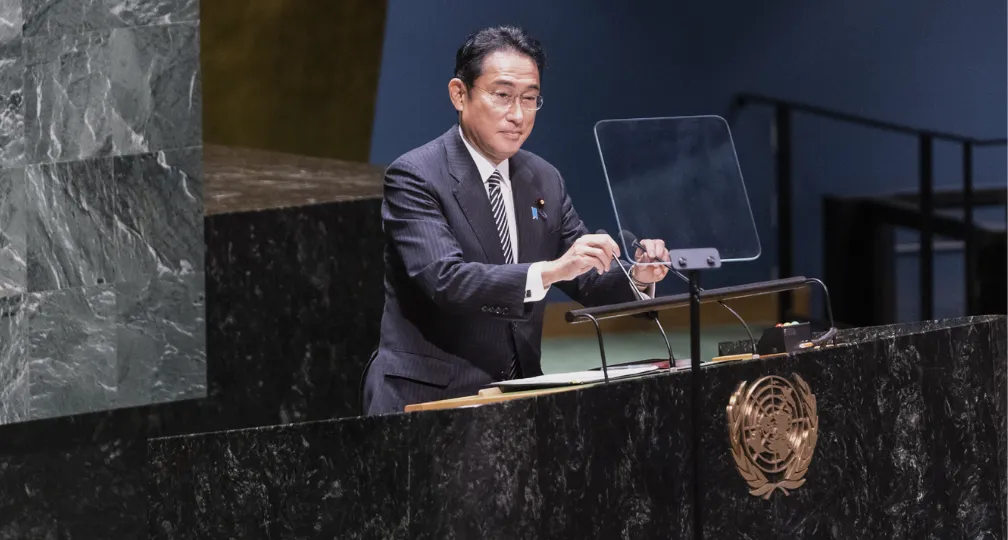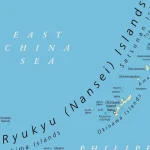Taking inspiration from Hiroshima to reconstruct the global nuclear order

Lieutenant General, Japan Air Self-Defense Force (Ret.)
This article was posted to the Japan Times on June 1, 2023:
https://www.japantimes.co.jp/opinion/2023/06/01/commentary/world-commentary/hiroshima-nuclear-order/
With the international order having been shaken to its roots as a result of Russia’s invasion of Ukraine, the recent Group of Seven summit offered a historic opportunity to demonstrate to the world the grouping’s strong determination to uphold the international order based on the rule of law, firmly rejecting any unilateral attempt to change the status quo by force or the threat or use of nuclear weapons.
Four of the world’s seven nuclear powers — the United States, the United Kingdom and France, as well as India, which was invited as a guest — gathered in Hiroshima, the world’s first atomic-bombed city, to discuss how to balance efforts toward a world without nuclear weapons with a realistic nuclear deterrence.
Ukrainian President Volodymyr Zelenskyy also made a surprise appearance to appeal for global support.
It is important that the leaders do not yield to Russia’s threats of using nuclear weapons and fully support Ukraine, which is fighting against Russia’s aggression, and never allow Russian President Vladimir Putin to push the nuclear button.
With Japan as this year’s G7 chair, Prime Minister Fumio Kishida has been tasked with making the first step toward recovering the global nuclear order by implementing his Hiroshima Action Plan, now endorsed by the G7’s Hiroshima Vision on Nuclear Disarmament.
Nuclear deterrence
The era following the Cold War, when people’s interest in nuclear weapons declined, led to the destabilization of the global nuclear order, with North Korea repeatedly holding nuclear tests and developing missiles; loosened arms control between the U.S. and Russia seen in their withdrawal from the Intermediate-Range Nuclear Forces (INF) Treaty; and China rapidly building up its nuclear force.
Russia, which unilaterally annexed Crimea in 2014, took the “escalate to de-escalate” strategy of deliberately escalating a conflict through measures including threatening to use nuclear weapons to intimidate an adversary to force it to accept conditions favorable for Russia.
Moscow has actually been using this strategy ever since it invaded Ukraine on Feb. 24, 2022, and the possibility of it using nuclear weapons still cannot be denied.
In response, U.S. President Joe Biden decided against military intervention by the U.S., thus failing to deter Russia’s military invasion.
However, regarding the use of nuclear weapons, Jake Sullivan, the U.S. national security adviser, said on Sept. 25 that Washington has communicated “directly, privately and at very high levels to the Kremlin that any use of nuclear weapons in Ukraine will be met with catastrophic consequences for Russia.”
Although Ukraine is not a NATO member, the U.S. has made public its intention to retaliate against any use of nuclear weapons in the country, because if they are actually used, it will lead to the collapse of not only the Nuclear Non-Proliferation Treaty (NPT) regime but also the U.S.’ nuclear strategy and extended deterrence strategy.
U.S. retaliation has the risk of bringing about Russian counterattacks using strategic nuclear weapons, potentially triggering a full-scale nuclear war.
Nevertheless, if the U.S. hesitates and Russia’s intrawar deterrence strategy manages to work, it could give other countries — North Korea, which is upgrading its capability to operate nuclear missiles, and China, which has not renounced the use of force in its bid to unite with Taiwan — a reason to adopt a similar strategy. And this could pose a serious challenge to Washington’s extended deterrence strategy for its allies.
Ukraine is indeed at a crucial point where the U.S.’ extended deterrence is being tested in actual warfare.
How to deter
The strategy of nuclear deterrence has become more sophisticated along with changes in the strategic environment and technological innovation since the Cold War.
It started with a “minimal deterrence” strategy — which means that, given the sheer destructive power of nuclear weapons, even a minimal possession is sufficient to threaten any potential adversary — but shifted over time to “flexible response,” by which deterrence is guaranteed by having multiple options available to achieve victory at minimal cost while retaining the use of nuclear weapons as an option.
Then came the idea of “mutual assured destruction.” By this principle, a nuclear attack by one superpower would be met with a swift counterattack, leaving both sides in a state of annihilation. This led, in part, to the now-defunct Anti-Ballistic Missile Treaty, which barred Washington and Moscow from deploying nationwide defenses against strategic ballistic missiles.
And today, there is the “escalate to de-escalate” strategy.
All of these strategies contain paradoxes and dilemmas, which means their validity can be proven only by the accumulation of evidence that nuclear weapons have not actually been used.
Conversely, deterrence could be seen as a result of both sides mutually influencing each other psychologically, and that it is almost impossible to make objective assessments.
Any of the strategies holds good as a theory as long as nuclear weapons are not used.
If nuclear weapons are used in Ukraine, all the armchair theories will be rendered useless and the future course of the war or the postwar deterrence theory will become totally unpredictable. The same will be true for Russia.
On June 2, 2020, Russia released its Basic Principles of State Policy of the Russian Federation on Nuclear Deterrence, which states that it “guarantees protection of national sovereignty and territorial integrity of the State, and deterrence of a potential adversary from aggression against the Russian Federation and/or its allies. In the event of a military conflict, this Policy provides for the prevention of an escalation of military actions and their termination on conditions that are acceptable for the Russian Federation and/or its allies.”
According to this policy, Moscow’s nuclear blackmail can be interpreted as being aimed at hampering any escalation in Ukraine’s counterattacks and suspending hostilities on conditions that are acceptable for Russia.
However, it should be noted that the “Policy” mentioned by Moscow is the policy on nuclear deterrence, which means that using nuclear weapons will actually make it difficult for Russia to achieve its goal, since the action is likely to lead to retaliation from the U.S.
To make sure nuclear deterrence will remain effective, it is critical to make Putin realize the contradiction and prevent him from crossing a line.
As Hirohito Ogi, a senior research fellow at the Institute of Geoeconomics, pointed out in his article on Russia’s nuclear blackmail in this series, it is also important to make clear that the use of tactical nuclear weapons will not be so effective.
The analysis of the reasons why nuclear weapons were not used in Ukraine will become the foundation for building a nuclear strategy and an extended deterrence after the war in Ukraine is over.
The NPT regime
Russia’s nuclear threats are forcing nonnuclear states to make the difficult decision of how to guarantee their security against hostile nuclear states, as can be seen in the case of Finland and Sweden choosing to drop their neutrality to come under NATO’s nuclear umbrella.
Ukraine joined the NPT in 1994 by agreeing to remove thousands of former Soviet nuclear warheads stationed on its territory. However, the 1994 Budapest Memorandum — signed by the U.S., the U.K. and Russia to provide security assurances for Ukraine in exchange for giving up this nuclear arsenal — was not adhered to.
The five major nuclear powers — the U.S., Russia, the U.K., France and China — also issued unilateral declarations on negative security assurance, a guarantee by a nuclear weapon state that it will not use or threaten to use nuclear weapons against nonnuclear weapon states.
But Russia broke this commitment, putting nonnuclear states’ confidence in the NPT regime in danger.
To maintain the NPT framework, fraught with inequality from the beginning, nuclear states should reaffirm their joint responsibility related to security assurances of nonnuclear states.
As for South Korea, despite consistent public support for possession of nuclear weapons, President Yoon Suk-yeol chose to help strengthen the U.S.’ extended deterrence, stating in the Washington declaration on April 26 that South Korea recognizes the benefit of its enduring reliance on the U.S. nuclear deterrent.
But how will he react if North Korea, which is working to improve its operational capability of tactical nuclear weapons, conducts its seventh nuclear test?
Needless to say, North Korea’s nuclear development affects Japan as well.
Furthermore, China is deviating from its minimal nuclear deterrence strategy and is projected to possess roughly 1,500 nuclear warheads by 2035, nearly equal to the stockpile held by the U.S.
If an era of a three-way nuclear rivalry between the U.S., Russia and China arrives, it will become impossible for each country to simultaneously pursue parity with the other two, because even if all the countries hold the same number of nuclear weapons, cooperation between two of the nations would mean putting the remaining country in a disadvantageous position.
A new challenge for arms control is how to prevent an arms race and reduce the risk of strategic instability under this three-way rivalry.
China, which is becoming a nuclear superpower, must pursue a responsible nuclear policy by at least improving its nuclear transparency.
China’s nuclear arsenal expansion also affects India’s nuclear strategy.
India chose not to join the NPT and successfully conducted nuclear tests in 1998, around the same time as Pakistan.
Ever since then, India has constantly denied the limited nuclear options approach — using nuclear weapons as a tactical tool to achieve victory in military operations — and has viewed nuclear arms as a political tool for deterrence.
Consequently, the country has maintained regional strategic stability along with Pakistan. Masahiro Kurita, an expert on nuclear strategy and South Asian security, wrote in a book titled “The End of Nuclear Forgetting: Revival of Nuclear Weapons” that India succeeded in suppressing the so-called stability-instability paradox — a situation in which two countries holding nuclear weapons greatly decrease the probability of a direct war, but increase the probability of minor or indirect conflicts.
Chinese leader Xi Jinping expressed his opposition on the use of nuclear weapons in a telephone call with Zelenskyy on April 26.
“There is no winner in a nuclear war,” Xi reportedly said, apparently referring to the threat of Russia using tactical nuclear weapons. “All parties concerned should remain calm and restrained in dealing with the nuclear issue.”
How will Indian Prime Minister Narendra Modi respond to this and plan his country’s future nuclear deterrence and China policy?
And how will other nuclear states — such as the U.S., the U.K. and France — guarantee security against nuclear threats to countries protected by extended nuclear deterrence such as Japan, Germany, Italy and Canada, as well as to all nonnuclear states?
The G7 Hiroshima Leaders’ Communique has confirmed support for Ukraine for as long as it takes in the face of Russia’s illegal war of aggression, and to strengthen disarmament and nonproliferation efforts, toward the ultimate goal of a world without nuclear weapons and with undiminished security for all. Related action should be taken.
Restarting from Hiroshima
On May 27, 2016, following the G7 Ise-Shima summit in Mie Prefecture, then-U.S. President Barack Obama visited Hiroshima, becoming the first sitting U.S. president to do so.
The scene of Obama hugging an elderly atomic-bomb survivor during the visit led to anticipation for an advance toward a world without nuclear weapons.
Obama’s speech in Prague in 2009 heightened the momentum for worldwide nuclear disarmament, leading to the adoption of the Treaty on the Prohibition of Nuclear Weapons (TPNW) at a United Nations conference in July 2017, with 122 states voting in favor.
The TPNW has not become an international norm, however, as nuclear states and their allies, including Japan, have not signed the treaty.
To begin with, there is no autonomous power that backs up the treaty to forcibly form an order.
This means that the establishment of international legal norms to regulate the use of nuclear weapons will come only in the distant future, if at all.
Even so, building common understanding on the inhumane nature of nuclear weapons in the international community is the high road to raising the hurdles for their use and making it a taboo.
In order to realize the ideal of nuclear abolition, it is also true that countries should first take measures grounded in the reality of nuclear deterrence and arms control.
Leaders who gathered at the G7 Hiroshima summit must have strongly felt the inhumanity of what had been done to the city.
They should take a new step from Hiroshima toward restoring the global nuclear order by averting a crisis of nuclear weapons use at hand while never giving up on the ideal of abolishing nuclear arms.
“Achieving the world we hope to see requires a global effort to take us from the harsh reality to the ideal, no matter how narrow the path may be,” said the G7 Leaders’ Hiroshima Vision on Nuclear Disarmament.
Japan and the U.S., which have historically had special responsibilities, must take the lead by pushing back against Russia’s nuclear threats and attacks, and setting an example of extended deterrence by which countries guarantee security through unwavering mutual trust.
(Photo Credit: ZUMA Press / Aflo)

Geoeconomic Briefing
Geoeconomic Briefing is a series featuring researchers at the IOG focused on Japan’s challenges in that field. It also provides analyses of the state of the world and trade risks, as well as technological and industrial structures (Editor-in-chief: Dr. Kazuto Suzuki, Director, Institute of Geoeconomics (IOG); Professor, The University of Tokyo).
Disclaimer: The opinions expressed in Geoeconomic Briefing do not necessarily reflect those of the International House of Japan, Asia Pacific Initiative (API), the Institute of Geoeconomics (IOG) or any other organizations to which the author belongs.
-
 Analysis: Ready for a (Tariff) Refund?2025.12.24
Analysis: Ready for a (Tariff) Refund?2025.12.24 -
 China, Rare Earths and ‘Weaponized Interdependence’2025.12.23
China, Rare Earths and ‘Weaponized Interdependence’2025.12.23 -
 Are Firms Ready for Economic Security? Insights from Japan and the Netherlands2025.12.22
Are Firms Ready for Economic Security? Insights from Japan and the Netherlands2025.12.22 -
 Is China Guardian of the ‘Postwar International Order’?2025.12.17
Is China Guardian of the ‘Postwar International Order’?2025.12.17 -
 Japan-India Defense in a Fragmenting Indo-Pacific2025.12.10
Japan-India Defense in a Fragmenting Indo-Pacific2025.12.10
 The “Economic Security is National Security” Strategy2025.12.09
The “Economic Security is National Security” Strategy2025.12.09 The Tyranny of Geography: Okinawa in the era of great power competition2024.02.09
The Tyranny of Geography: Okinawa in the era of great power competition2024.02.09 Event Report: The Trump Tariffs and Their Impact on the Japanese Economy2025.11.25
Event Report: The Trump Tariffs and Their Impact on the Japanese Economy2025.11.25 Trump’s Tariffs Might Be Here to Stay – No Matter Who’s in Power2025.11.28
Trump’s Tariffs Might Be Here to Stay – No Matter Who’s in Power2025.11.28 The Real Significance of Trump’s Asia Trip2025.11.14
The Real Significance of Trump’s Asia Trip2025.11.14













